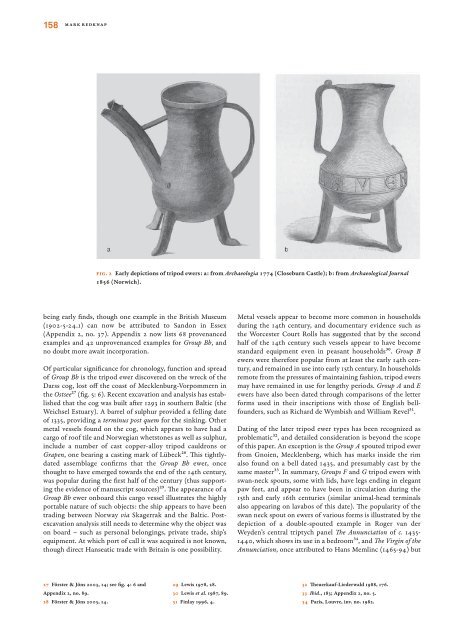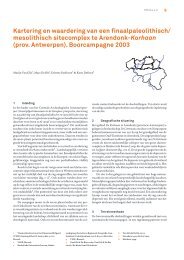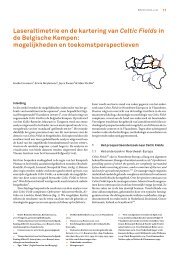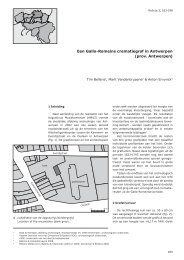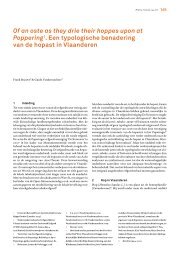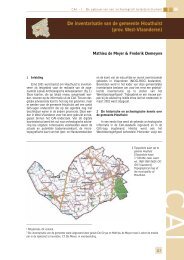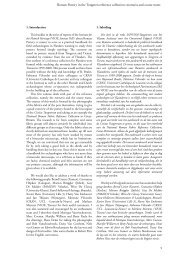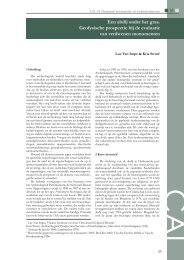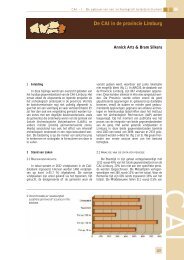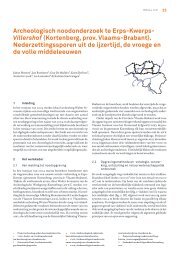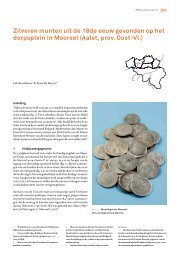Exchanging Medieval Material Culture Studies on archaeology and ...
Exchanging Medieval Material Culture Studies on archaeology and ...
Exchanging Medieval Material Culture Studies on archaeology and ...
Create successful ePaper yourself
Turn your PDF publications into a flip-book with our unique Google optimized e-Paper software.
158<br />
Mark Redknap<br />
27 Förster & Jöns 2003, 14; see fi g. 4: 6 <strong>and</strong><br />
Appendix 2, no. 89.<br />
28 Förster & Jöns 2003, 14.<br />
Fig. 2 Early depicti<strong>on</strong>s of tripod ewers: a: from Archaeologia 1774 (Closeburn Castle); b: from Archaeological Journal<br />
1856 (Norwich).<br />
being early fi nds, though <strong>on</strong>e example in the British Museum<br />
(1902-5-24.1) can now be attributed to S<strong>and</strong><strong>on</strong> in Essex<br />
(Appendix 2, no. 37). Appendix 2 now lists 68 provenanced<br />
examples <strong>and</strong> 42 unprovenanced examples for Group Bb, <strong>and</strong><br />
no doubt more await incorporati<strong>on</strong>.<br />
Of particular signifi cance for chr<strong>on</strong>ology, functi<strong>on</strong> <strong>and</strong> spread<br />
of Group Bb is the tripod ewer discovered <strong>on</strong> the wreck of the<br />
Darss cog, lost off the coast of Mecklenburg-Vorpommern in<br />
the Ostsee27 (fi g. 5: 6). Recent excavati<strong>on</strong> <strong>and</strong> analysis has established<br />
that the cog was built aft er 1293 in southern Baltic (the<br />
Weichsel Estuary). A barrel of sulphur provided a felling date<br />
of 1335, providing a terminus post quem for the sinking. Other<br />
metal vessels found <strong>on</strong> the cog, which appears to have had a<br />
cargo of roof tile <strong>and</strong> Norwegian whetst<strong>on</strong>es as well as sulphur,<br />
include a number of cast copper-alloy tripod cauldr<strong>on</strong>s or<br />
Grapen, <strong>on</strong>e bearing a casting mark of Lübeck28. Th is tightlydated<br />
assemblage c<strong>on</strong>fi rms that the Group Bb ewer, <strong>on</strong>ce<br />
thought to have emerged towards the end of the 14th century,<br />
was popular during the fi rst half of the century (thus supporting<br />
the evidence of manuscript sources)29. Th e appearance of a<br />
Group Bb ewer <strong>on</strong>board this cargo vessel illustrates the highly<br />
portable nature of such objects: the ship appears to have been<br />
trading between Norway via Skagerrak <strong>and</strong> the Baltic. Postexcavati<strong>on</strong><br />
analysis still needs to determine why the object was<br />
<strong>on</strong> board – such as pers<strong>on</strong>al bel<strong>on</strong>gings, private trade, ship’s<br />
equipment. At which port of call it was acquired is not known,<br />
though direct Hanseatic trade with Britain is <strong>on</strong>e possibility.<br />
29 Lewis 1978, 28.<br />
30 Lewis et al. 1987, 89.<br />
31 Finlay 1996, 4.<br />
Metal vessels appear to become more comm<strong>on</strong> in households<br />
during the 14th century, <strong>and</strong> documentary evidence such as<br />
the Worcester Court Rolls has suggested that by the sec<strong>on</strong>d<br />
half of the 14th century such vessels appear to have become<br />
st<strong>and</strong>ard equipment even in peasant households30. Group B<br />
ewers were therefore popular from at least the early 14th century,<br />
<strong>and</strong> remained in use into early 15th century. In households<br />
remote from the pressures of maintaining fashi<strong>on</strong>, tripod ewers<br />
may have remained in use for lengthy periods. Group A <strong>and</strong> E<br />
ewers have also been dated through comparis<strong>on</strong>s of the letter<br />
forms used in their inscripti<strong>on</strong>s with those of English bellfounders,<br />
such as Richard de Wymbish <strong>and</strong> William Revel31.<br />
Dating of the later tripod ewer types has been recognized as<br />
problematic32, <strong>and</strong> detailed c<strong>on</strong>siderati<strong>on</strong> is bey<strong>on</strong>d the scope<br />
of this paper. An excepti<strong>on</strong> is the Group A spouted tripod ewer<br />
from Gnoien, Mecklenberg, which has marks inside the rim<br />
also found <strong>on</strong> a bell dated 1435, <strong>and</strong> presumably cast by the<br />
same master33. In summary, Groups F <strong>and</strong> G tripod ewers with<br />
swan-neck spouts, some with lids, have legs ending in elegant<br />
paw feet, <strong>and</strong> appear to have been in circulati<strong>on</strong> during the<br />
15th <strong>and</strong> early 16th centuries (similar animal-head terminals<br />
also appearing <strong>on</strong> lavabos of this date). Th e popularity of the<br />
swan neck spout <strong>on</strong> ewers of various forms is illustrated by the<br />
depicti<strong>on</strong> of a double-spouted example in Roger van der<br />
Weyden’s central triptych panel Th e Annunciati<strong>on</strong> of c. 1435-<br />
1440, which shows its use in a bedroom34, <strong>and</strong> Th e Virgin of the<br />
Annunciati<strong>on</strong>, <strong>on</strong>ce attributed to Hans Memlinc (1465-94) but<br />
32 Th euerkauf-Liederwald 1988, 176.<br />
33 Ibid., 183; Appendix 2, no. 5.<br />
34 Paris, Louvre, inv. no. 1982.


